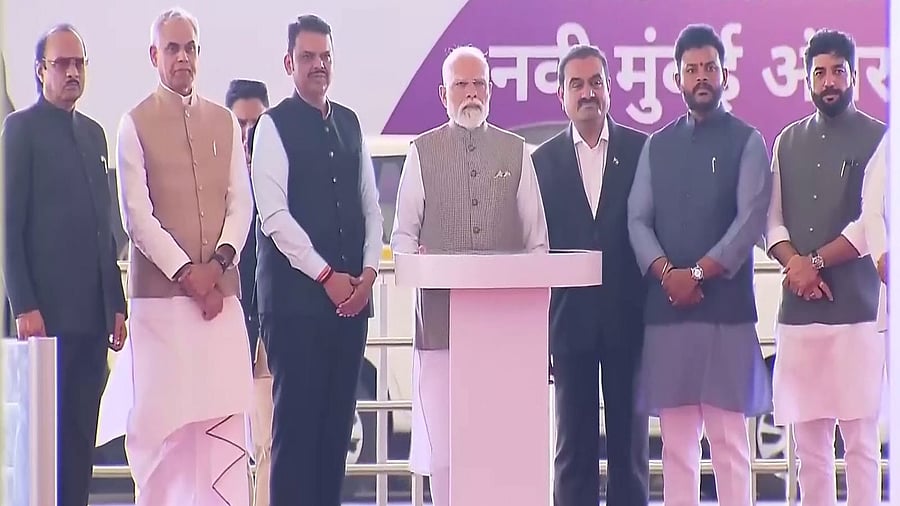
PM Narendra Modo inaugurates the new airport.
Credit: ANI
Raigad: India’s financial capital of Mumbai is set to emerge as Asia’s premier connectivity hub with a twin-airport model of global standards, Prime Minister Narendra Modi said.
Mumbai has two airports now - the existing Chhatrapati Shivaji Maharaj Airport at Santacruz-Sahar in Mumbai and the Navi Mumbai International Airport at Ulwe in the Raigad district, which was commissioned on Wednesday.
“Mumbai welcomed its second international airport, today, marking a significant milestone in its journey to becoming Asia's premier connectivity hub. This new airport is set to play a pivotal role in enhancing regional and global connectivity,” Modi, on a two-day visit to Mumbai, said inaugurating a host of projects including the NMIA.
“The new airport reflects the vision of a developed India…a Viksit Bharat is one where there is both momentum and progress, where public welfare is paramount and government schemes make life easier for every citizen,” he said.
Billed as a transformative mega-infrastructure project, NMIA has been developed as a Greenfield airport by the City and Industrial Development Corporation of Maharashtra Ltd (CIDCO) and Adani Airports Holdings Pvt Ltd (AAHPL), which is part of the Adani Group.
The NMIA is being developed under the Public Private Partnership (PPP) framework on a Design, Build, Finance, Operate and Transfer (DBFOT).
The new airport will transform the Mumbai metropolitan region (MMR), which comprises the twin districts of Mumbai City and Mumbai Suburban and large stretches of adjoining districts of Palghar-Thane-Raigad.
By 2032, the CSMIA and NMIA will be in a position to handle the 150–160 million passengers annually.
The NMIA–CSMIA pairing positions Mumbai firmly alongside the world’s most sophisticated multi-airport systems. Data shows that Dubai International (DXB) already accommodates more than 90 million passengers annually, with Al Maktoum International (DWC) being scaled to eventually exceed 120 million. London’s network of Heathrow, Gatwick, Stansted and Luton manages over 180 million passengers, while New York distributes about 130 million across JFK, Newark and LaGuardia.
The NMIA is named as Loknete DB Patil Navi Mumbai International Airport after late lawyer, politician, farmers’ leader and social activist, Dinkar Balu Patil, who was popularly known as D B Patil - and commanded tremendous respect in the Raigad area of coastal Konkan belt for work towards Project Affected People (PAP).
“D B Patil’s spirit of service is an inspiration to all, and his life will continue to motivate those working in public life,” said Modi.
“ Built on the land of Chhatrapati Shivaji Maharaj, the airport is shaped like a lotus flower, symbolizing culture and prosperity. This new airport will connect Maharashtra’s farmers to supermarkets in Europe and the Middle East, enabling fresh produce, fruits, vegetables, and fishery products to reach global markets swiftly. The airport will reduce export costs for nearby small and medium industries, boost investment, and lead to the establishment of new enterprises,” he said.
Recalling his 2014 address upon assuming office, Modi reiterated his vision that even those wearing hawai-chappals should be able to do hawai-yatra.
“To realize this dream, it was essential to build new airports across the country. Over the past eleven years, new airports have been constructed one after another. In 2014, India had only 74 airports; today, the number has crossed 160,” he said.
The Prime Minister stated that the construction of airports in smaller cities has provided residents with new options for air travel. To address financial constraints, the government launched the UDAN scheme, aimed at making air tickets affordable for the common citizen.
He highlighted that over the past decade, millions of people have flown for the first time under this scheme, fulfilling their long-held dreams.
Pointing out that as the number of aircraft increases, the demand for maintenance and repair operations also rises, the PM highlighted that India is developing new facilities domestically to meet this need.
He affirmed that the goal is to establish India as a major MRO (Maintenance, Repair, and Overhaul) hub by the end of this decade.